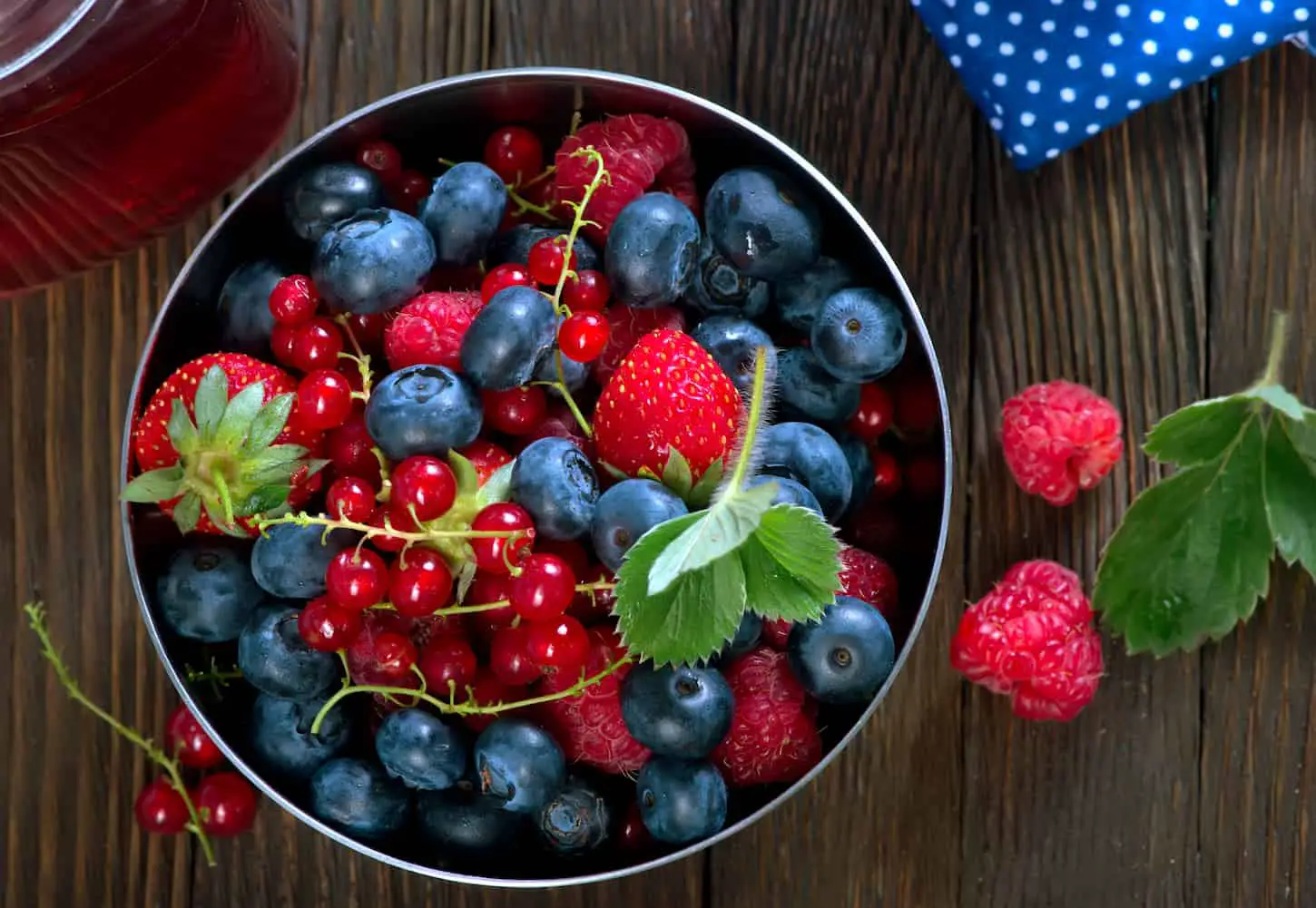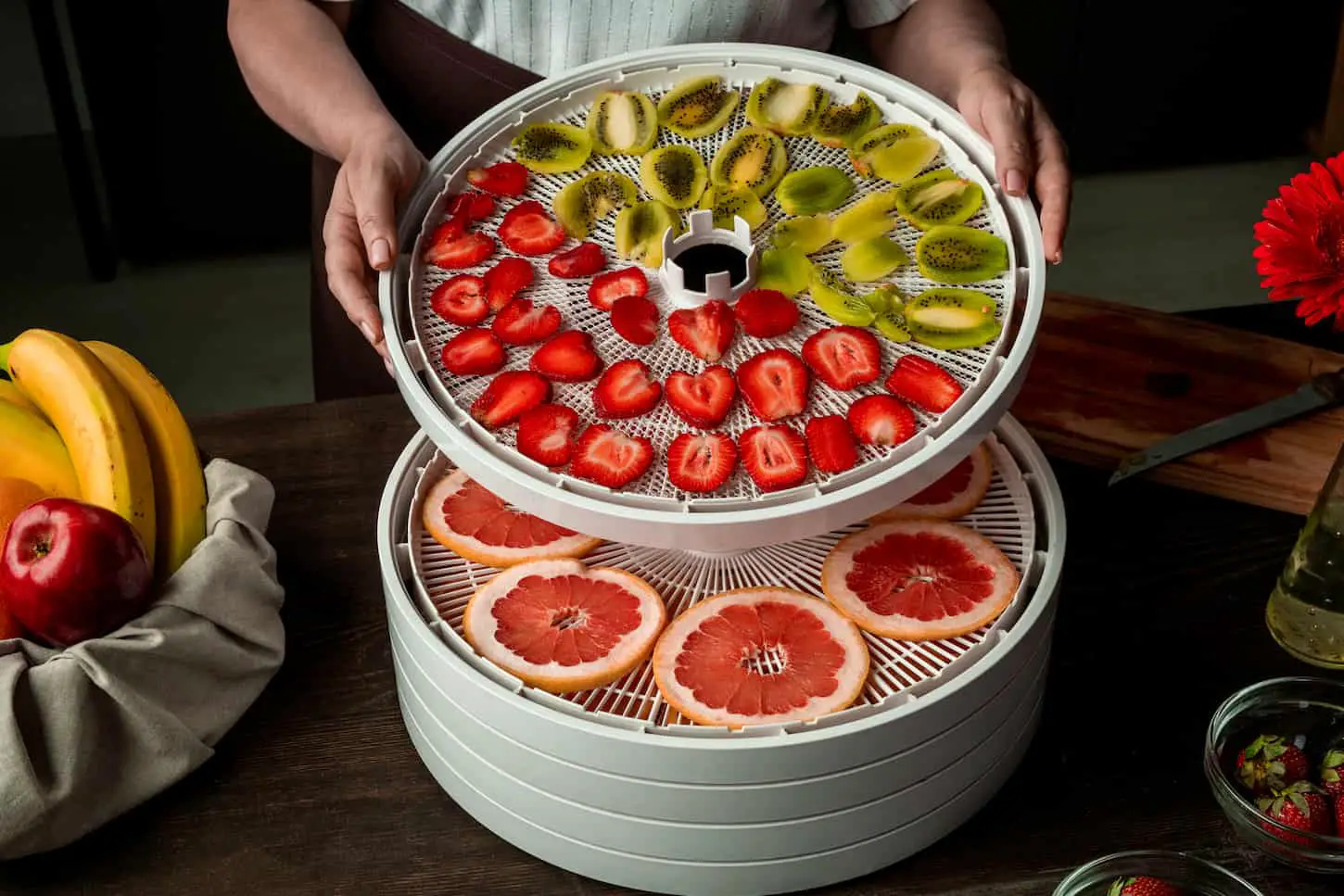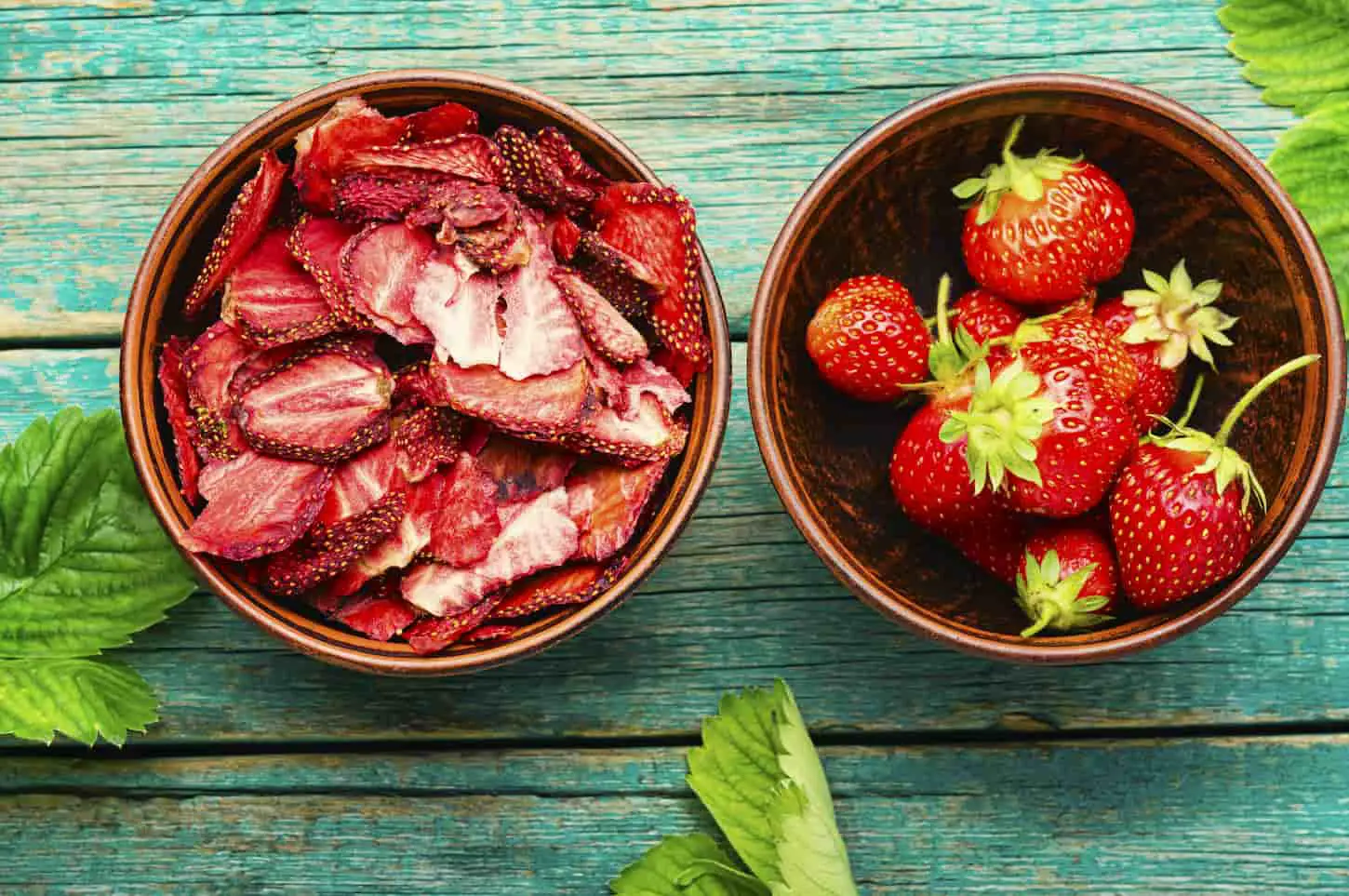Dehydration is one of the most popular methods of long-term food storage, and berries can also be dehydrated. We’re happy to say that berries are no more difficult to dehydrate than other foods.
To dehydrate berries, we must do the following:
- Wash the berries and, if desired, treat them with ascorbic acid to prevent browning
- Dry them in an oven, a dehydrator, or in the sun
- Store them in airtight bags or plastic containers
There’s a bit more to this story, though. Which method is best? How long can dehydrated berries stay stored? Is buying a dehydrator worth it for berries? In this article, we’ll be answering all these questions!

Can Berries Be Dehydrated or Dried?
Berries can be dehydrated – one of the best ways to preserve them long-term. Dehydrated berries shrink and lose their firmness, so fresh berries and dehydrated taste slightly different.
We can buy dehydrated berries in most stores, so try some store-bought berries before dehydrating your own. That way, you can make sure that this is the best long-term storage solution for you and your family.
It’d be pointless and a huge waste of food to dehydrate a few pounds of grapes (or any other fruit) only to find out that we hate the taste and throw them away.

How Do You Dehydrate Fresh Berries?
There are three different dehydration methods for any food, including berries – solar dehydration, oven dehydration, and dehydration in a food dehydrator.
Dehydrating food is a rather simple process and mostly relies on equipment. It doesn’t require too much participation on our part.
Solar drying is the slowest but also the cheapest dehydration option. Food dehydrators are the most expensive option, and while they’re by far the best option, we recommend that you try dehydrating in the oven first to prevent wasting money.
If you like it – invest in a food dehydrator, as it will save a lot of time, and you won’t have to use the oven whenever you want to dehydrate food.
Here’s how to dehydrate food.
Preparation
To dehydrate food, you’ll need the following:
- A food dehydrator, an oven, or a safe place in the sun to dry the berries
- Dehydrating trays (stainless steel trays or food-grade plastic are best since they don’t oxidize)
- Ascorbic acid
- Airtight containers or bags (preferably vacuum-sealing bags)
Step 1 – Wash and pretreat the berries with ascorbic acid
Start by washing the berries, so they are clean of visible dirt or mess. If you don’t want to retreat the berries with ascorbic acid, wash them well so they’re clean. However, if you use ascorbic acid as part of the pretreating process, you don’t have to be as thorough with mechanical cleaning, as the acid will help clean the berries.
Ascorbic acid can come in the form of crystals (much like salt), so combine it with water to activate the crystals. Follow the instructions on the packaging to do this. In most cases, we’ll have to combine 2.5 tablespoons with a liter of cold water or a similar ratio. If you don’t have ascorbic acid, citric acid also works.
The acid is used here to keep the fruit from darkening (especially important if we store it in the freezer to avoid freezer burn) and helps destroy bacteria.
The general rule is to soak 10 quarts of fruit in a quart of the ascorbic acid solution for about 10 minutes. Once they are treated, let them air dry well before dehydrating. Dehydrating them while wet will take longer.
Step 2 – Dehydrate the berries (solar/oven/dehydrator)
In this step, we’ll explain all three methods of dehydration below.
Sun and solar drying
Because of the high sugar content and acidity of fruits, they’re safe to dry in the sun. The same can’t be said for meats and vegetables, so know that this method is for fruit only!
To dry in the sun, we need to live in a hot, dry area – humidity needs to be below 60%, and the temperature needs to be at least 86°F (about 30°C). Line up the berries on the drying trays in a single layer.
Leave them out in a safe spot (somewhere the dog or birds won’t get to them) for as long as possible.
Place the trays on wooden blocks so the middle of the tray is completely open and aeration can do its job. Bring the trays back in once the sun goes down, as nighttime will remoisturize the berries.
When it comes to solar drying, it’s very similar to sun drying.
It would be best to build a simple solar oven with aluminum foil and a plastic sheet to maximize the temperature and eliminate moisture. This can also help keep out most animals (birds included), so the food stays safe.
We’ll know that the berries are dry once we shake the tray and they rattle – this means they’ve gotten firm, which happens when they dehydrate completely.
Oven dehydrating
Before buying a food dehydrator, try this method. This is a bit slower than an actual dehydrator because there’s no fan in the oven to move the air around. Oven dehydration can take twice as long as dehydrator dehydration.
To dehydrate in the oven, let it heat up to 140°F. It can’t be hotter than this, as the berries will cook.
The best way to ensure some air circulation is by jamming the door open at six inches or less. Set the berries on the trays in single layers and put them inside the oven. This will heat up your kitchen, so it’s not an ideal summertime activity. It’s great in the winter, though!
There’s no specific time frame for drying berries in the oven, as it greatly depends on air circulation. However, we’ll know they’re done the same way we would check the solar dehydrator – dry berries rattle when we shake the tray.
Dehydrating in a dehydrator
The quickest and most efficient way of dehydrating is in a dehydrator. Dehydrators have both a heater and a fan, which makes the entire process quicker, more efficient, and more evenly done.
Most dehydrators already have a set temperature of 140°F, but if the model has the option of setting the temperature, choose 140°F. Load the berries and let the dehydrator do its thing. It can take anywhere from a few hours to a day, depending on how large the dehydrator is and how many berries are in it.
That’s all there is to it! Shake the tray to see if the berries are done. If they’re not, put the tray back in. If they’re done, take the tray out.
Step 3 – Store the berries
Before packing the berries, they have to cool down. The best storage options are moisture and vapor-resistant containers or airproof bags (provided there is a vacuuming machine).
Store the packs in a cool, dark, and dry place, or put them in the freezer – this will prolong the longevity of dried berries.
How Long Does It Take to Dehydrate Berries?
Dehydrating a tray of berries can take between 8 and 24 hours. There is no fixed time period, as that depends on the model of the dehydrator or dehydration method used. More efficient dehydrators take less time than solar dehydration or oven-based dehydrating.
Dehydrating in the oven will take much longer than a dedicated dehydrator but not as long as solar dehydration, while solar dehydration can take more than a day.
What Is The Right Temperature for Dehydrating Berries?
The highest temperature at which you can dehydrate berries is 140°F. Anything above will cook the berries, and anything below that will dehydrate berries less efficiently.
Since many ovens don’t have such low-temperature settings, they can’t dehydrate berries well. Our oven’s lowest temperature is 200°F, so we can’t dehydrate berries in our oven. Thankfully, we’ve got an Excalibur dehydrator that we love.
How Long Do Berries Last When Dehydrated?
Berries can last up to a year (sometimes 2-3 years) if kept in a cool, dark, and dry place, but that period is prolonged if we put the dehydrated berries in the freezer.
This is a general rule for all fruit, and different fruits don’t have different lasting times when dehydrated.

Dehydrating Berries FAQs
Frequently Asked Questions
We’re here to help! Check out our FAQs section below for answers to common questions. If we missed yours, let us know, and we’ll update the article. Contact us through our website, and we’ll respond directly to your question.
What fruit cannot be dehydrated?
There are few fruits that cannot be dehydrated. Olives can but should not be dehydrated because they last long without dehydration, and drying causes taste loss. Avocadoes cannot be dehydrated because they spoil quickly when they dry – they have a lot of fat.
Fruits we can dehydrate besides berries are apples, pears, pineapples, nectarines, plums, cherries, grapes, figs, apricots, bananas, and (believe it or not) melons.
Many people are freaked out when they learn that they can dry melons (both cantaloupes and watermelons) because of their high water content, but it’s not that difficult. The trick is in how thick you cut each piece to dehydrate.
Do you need to blanch berries before dehydrating them?
Blanching is not needed for fruit, but it is necessary for dehydrating vegetables. Pretreating berries with ascorbic acid is the equivalent of vegetable blanching for fruit dehydration.
How can you use dehydrated berries?
We can eat dry berries the way they are or freshen them up (rehydrate them). To freshen the berries up, soak them in water (at room temperature) for at least half an hour. A cup of berries needs at least 1.5 cups of water.
We can also cook dry berries (or any other fruit, for that matter) by covering them with boiling water for about 15 minutes. Fruits are often dried for future jam-making, which isn’t uncommon.

Key Takeaways and Next Steps
Berry dehydration is a simple process, and it doesn’t require too much work on our part. We must wash the berries, treat them with ascorbic acid, line them up on the tray, and let them dry.
Dehydration in a dehydrator is the quickest of all methods, but we can also use the oven or let them dry in the sun.
Dehydrating the berries loses a small amount of their nutritional value, but they can remain stored for a year, perhaps even more.
Ready to dehydrate more foods? Check out our master guide to dehydrating: What Is the Best Way to Dehydrate Food?
Resources
Learning from your own experience is essential, but learning from others is also intelligent. These are the sources used in this article and our research to be more informed as homesteaders.
- Colorado State University Extension. “Drying Fruits – 9.309.” Extension, 25 Feb. 2016, extension.colostate.edu/topic-areas/nutrition-food-safety-health/drying-fruits-9-309.
- Food and Nutrition series preparation – UGA. (n.d.). Retrieved December 10, 2022, from https://nchfp.uga.edu/how/dry/csu_dry_fruits.pdf
- How drying preserves food – UGA. (n.d.). Retrieved December 10, 2022, from https://nchfp.uga.edu/publications/uga/uga_dry_fruit.pdf
- National Center for Home Food Preservation | How Do I? Dry. nchfp.uga.edu/how/dry/pack_store.html.
